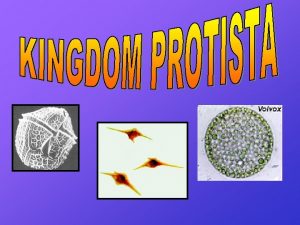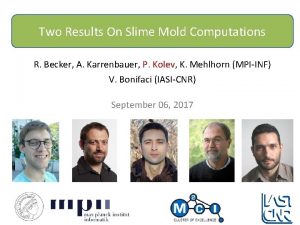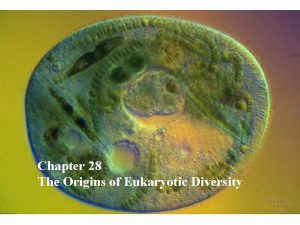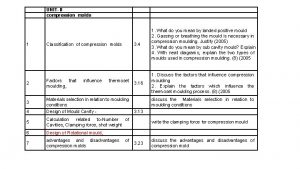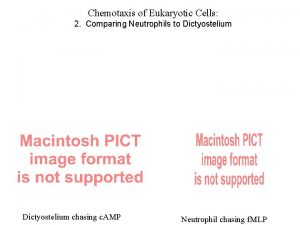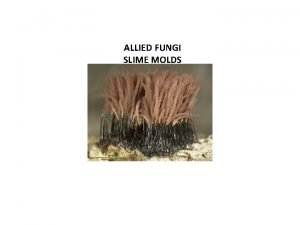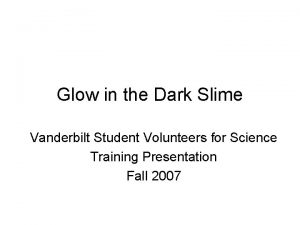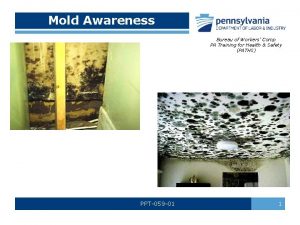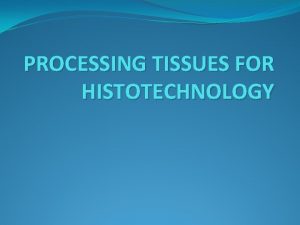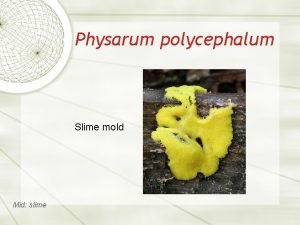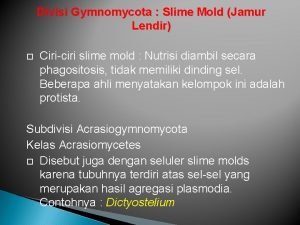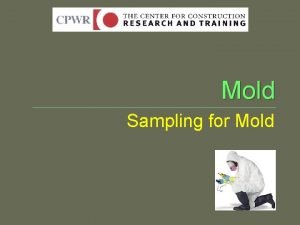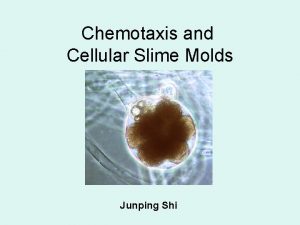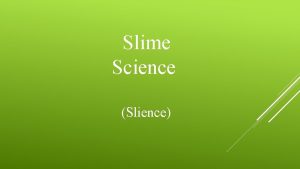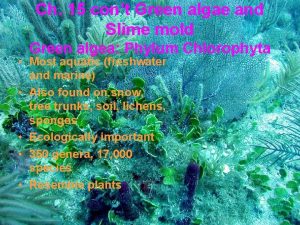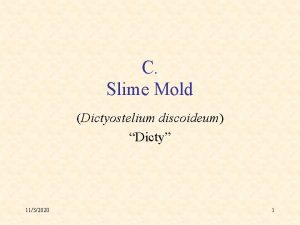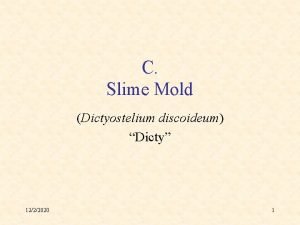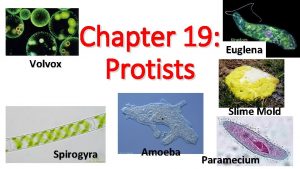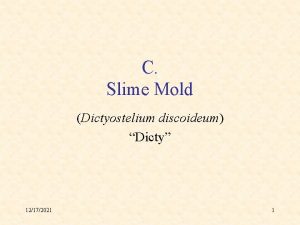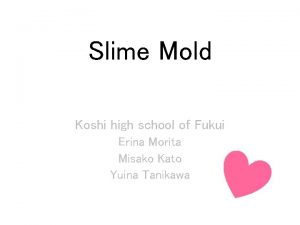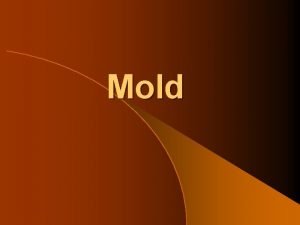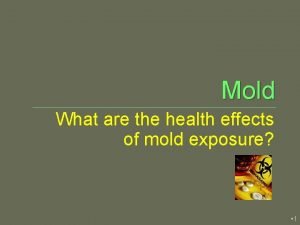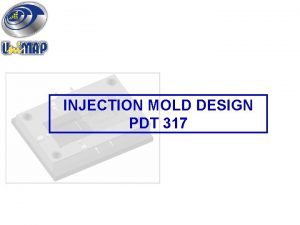CHEMOTAXIS OF SLIME MOLD Shuntarou Oishi Haruka Tsuruoka






























- Slides: 30

CHEMOTAXIS OF SLIME MOLD Shuntarou Oishi Haruka Tsuruoka Miku Nariyama Haruka Nishimura

Summary Slime mold naturally avoids chemical substances that it dislikes. We tried to make an evacuation map to test this ability. We found out about how slime mold reacts to chemical substance because we had questions about the nature of slime mold.

Introduction Slime molds are single-celled organisms. They are divided into two kinds. They are Physarum and Dictyostelium. Both of them like dark and wet places. Slime molds can move freely. Slime molds avoid citric acid. So we tested using other acids.

Experiment 1 Does slime mold spread equally without stimuli? Do slime molds move differently on the outside and the inside?


Hypothesis Slime mold spread equally when it gets a stimulus. The outside of slime mold is more expandable than the inside of it.

Result ①They spread equally without stimuli. ②They didn’t spread equally without stimuli. A Outside Inside B C ① 100% ① 90% ② 10% ① 70% ① 100% ② 30% ① 80% ② 20%

Slime mold spread equally without stimulus. Slime molds don’t move differently on the outside and the inside.

Tube structure of Slime mold Inner layer

Experiment 2 How does slime mold react to each chemical substance?

①Succinic acid 0. 1 mol/L Succinic acid 0. 5 mol/L 1. 0 mol/L

Experimental method Negative chemotaxis Positive chemotaxis

For measuring p. H

Hypothesis Slime mold shows negative chemotaxis.

Result negative chemotaxis positive chemotaxis

p. H~Succinic acid~ 〈0. 1 mol/L〉 〈1. 0 mol/L〉 p. H 6. 3 p. H 5. 4 p. H 4. 8 p. H 4. 5 p. H 5. 4 p. H 4. 6 p. H 4. 2 p. H 4. 0 〈0. 5 mol/L〉 p. H 5. 9 p. H 4. 2 p. H 4. 9 p. H 4. 4 : 3 cm : 2 cm : 1 cm : 0 cm

②Oxalic acid <The chemical substance which I used> ☆oxalic acid 0. 1 mol/L , 0. 5 mol/L , 1. 0 mol/L

Experimental method ☆We did the same experiment as with succinic acid. ☆But we didn’t experiment to examine positive chemotaxis against oxalic acid of 0. 5 mol/L and 1. 0 mol/L.

Hypothesis Slime mold will show negative chemotaxis.

Result(negative)~ 0. 1 mol/L~ Immediately after the experiment One day later ↑Experiment of negative chemotaxis p. H 6. 1(Center)

Result(positive)~ 0. 1 mol/L~ Experiment of positive chemotaxis↓ One day later Immediately after the experiment p. H 6. 6(0. 7 cm) p. H 6. 9(3. 0 cm) Slime mold

Result~ 0. 5 mol/L~ the next day of experiment 0. 8 cm→ 1. 1 cm→ One day later Experiment of negative chemotaxis

Result☆p. H☆ p. H 4. 7(1. 1 cm) slime mold p. H 4. 4(0. 8 cm)

Result~ 1. 0 mol/L~ Immediately after the experiment One day later Experiment of negative chemotaxis 2 cm the next day of experiment

the next day of experiment Continuation Experiment of negative chemotaxis Four day later After 5 days of the experiment

☆p. H☆~ 1. 0 mol/L~ p. H 4. 3(2. 0 cm) the next day of experiment ※we could not find the outside boundary. p. H 4. 1(2 cm) p. H 3. 8(0. 6 cm) p. H 3. 8(0. 4 cm) After 5 days of the experiment

Result~Oxalic acid~ 0. 1 mol/L 0. 5 mol/L 1. 0 mol/L Positive negative⇒ Oxalic acid chemotaxis positive ※『negative⇒positive』 means after the slime mold showed a negative chemotaxis, it showed positive chemotaxis.

Discussion of Experiment 2 ☆We think slime mold doesn’t have chemotaxis against succinic acid. ☆At first, slime mold made a stop circle because p. H of oxalic acid was less than 4. But then, slime mold showed positive chemotaxis when the p. H was more than 4. Because there was a slime mold in less than p. H 4 , when we experimented with oxalic acid 1. 0 mol/L, slime mold is likely to exhibit some chemotaxis to something other than p. H.

Outlook We want to examine the chemotaxis of slime molds against substances with a carboxyl group. And, slime molds don’t move by only p. H, so we want to test how substances affect slime molds For example: The relationship of organic acids and cell membrane receptors.

Thank you for listening!!
 Fungi vs protist
Fungi vs protist Is a paramecium autotrophic or heterotrophic
Is a paramecium autotrophic or heterotrophic Pyrrophyta
Pyrrophyta How do you kill slime mold
How do you kill slime mold Slime mold grounded
Slime mold grounded The origin - chapter 28
The origin - chapter 28 Plunger type transfer moulding
Plunger type transfer moulding Pot type mold & plunger type mold are the classification of
Pot type mold & plunger type mold are the classification of Chemotaxis
Chemotaxis Chemotaxis
Chemotaxis Chemotaxis
Chemotaxis Chemotaxis pathway
Chemotaxis pathway Yoko
Yoko Maeda haruka
Maeda haruka Allied fungi general characteristics
Allied fungi general characteristics Conjugated fungi
Conjugated fungi Diversity among protoctista
Diversity among protoctista Glow inthe dark
Glow inthe dark Organic compounds made by living things
Organic compounds made by living things Cellular vs plasmodial slime molds
Cellular vs plasmodial slime molds Slime the primordial
Slime the primordial Glooze slime
Glooze slime Mystery snail slime
Mystery snail slime Office appliance mold factory
Office appliance mold factory Mold awareness training
Mold awareness training Cold slug in injection molding
Cold slug in injection molding Tar fossil
Tar fossil Leuckhart’s embedding mold
Leuckhart’s embedding mold Permanent mold casting
Permanent mold casting In mold
In mold Marker fossils
Marker fossils

